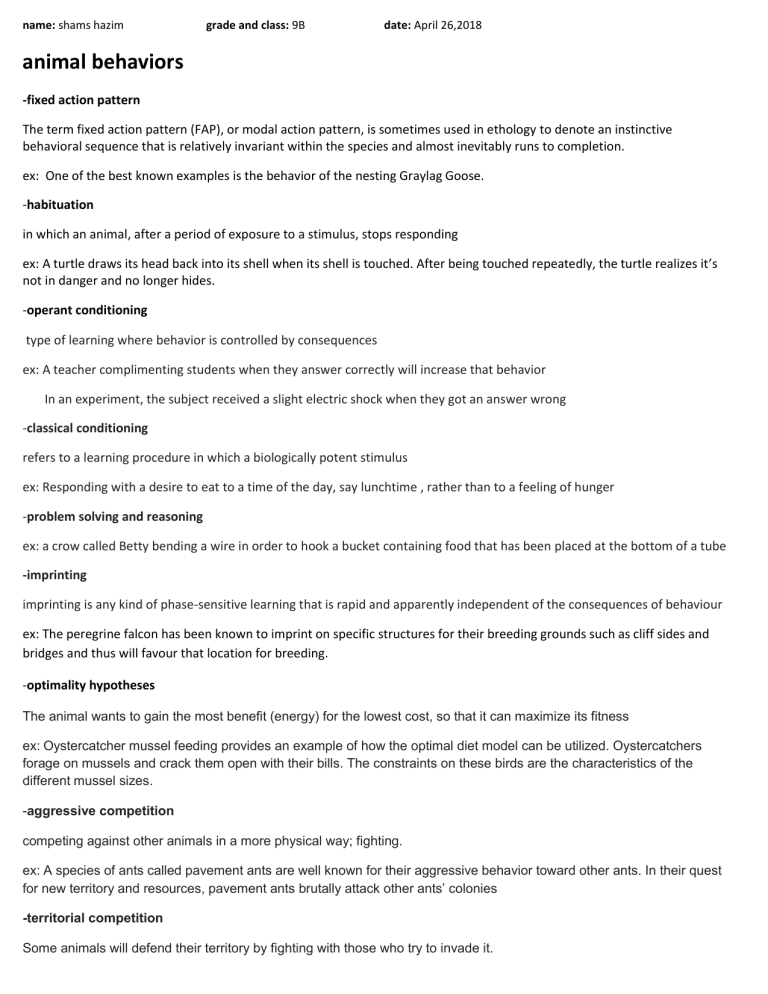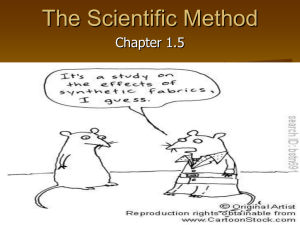
name: shams hazim grade and class: 9B date: April 26,2018 animal behaviors -fixed action pattern The term fixed action pattern (FAP), or modal action pattern, is sometimes used in ethology to denote an instinctive behavioral sequence that is relatively invariant within the species and almost inevitably runs to completion. ex: One of the best known examples is the behavior of the nesting Graylag Goose. -habituation in which an animal, after a period of exposure to a stimulus, stops responding ex: A turtle draws its head back into its shell when its shell is touched. After being touched repeatedly, the turtle realizes it’s not in danger and no longer hides. -operant conditioning type of learning where behavior is controlled by consequences ex: A teacher complimenting students when they answer correctly will increase that behavior In an experiment, the subject received a slight electric shock when they got an answer wrong -classical conditioning refers to a learning procedure in which a biologically potent stimulus ex: Responding with a desire to eat to a time of the day, say lunchtime , rather than to a feeling of hunger -problem solving and reasoning ex: a crow called Betty bending a wire in order to hook a bucket containing food that has been placed at the bottom of a tube -imprinting imprinting is any kind of phase-sensitive learning that is rapid and apparently independent of the consequences of behaviour ex: The peregrine falcon has been known to imprint on specific structures for their breeding grounds such as cliff sides and bridges and thus will favour that location for breeding. -optimality hypotheses The animal wants to gain the most benefit (energy) for the lowest cost, so that it can maximize its fitness ex: Oystercatcher mussel feeding provides an example of how the optimal diet model can be utilized. Oystercatchers forage on mussels and crack them open with their bills. The constraints on these birds are the characteristics of the different mussel sizes. -aggressive competition competing against other animals in a more physical way; fighting. ex: A species of ants called pavement ants are well known for their aggressive behavior toward other ants. In their quest for new territory and resources, pavement ants brutally attack other ants’ colonies -territorial competition Some animals will defend their territory by fighting with those who try to invade it. The songs of birds, the drumming of woodpeckers, and the loud calls of monkeys are all warnings that carry for long distances, advertising to potential intruders that someone else's territory is being approached. -dominance hierarchies when a deer avoids a lion knowing it might be attacked and that if it was attacked it would surely lose. -social groups Animals that live in groups with other members of their species are called social animals. Social animals include many species of insects, birds, and mammals. ex: Specific examples of social animals are ants, bees, crows, wolves, lions, and humans -altruism defined as an act in which an animal sacrifices its own well-being for the benefit of another animal As they recently described in Marine Mammal Science, the researchers were observing a pod of eleven killer whales attacking a Weddell seal that had sought refuge on an ice floe. -sexual selection picking mates according to certain traits. ex: A similar dimorphism occurs in the northern sea lion, Eumetopias jubata, where males weigh about 1,000 kg (2,200 pounds), about three times as much as females. The males fight fiercely in their competition for females; large, battlescarred males occupy their own rocky islets, each holding a harem of as many as 20 females. -mating system A mating system describes how males and females pair when choosing a mate ex: in humans as the monogamy type. although there are more types such as polygamy. -parental behaviors behaviors that parents show as care for their offspring ex: Baby orangutans are entirely dependent on their mother and breastfeed up to eight years in some cases. For the first two years of life, baby orangutans cling to their mother's belly, depending on her for all transportation. Orangutans teach their young where to find food, what to eat, and how to avoid predators. - sight communication Visual communication involves signals that can be seen. Examples of these signals include gestures, facial expressions, body postures, and coloration. ex: chimpanzees communicate a threat by raising their arms, slapping the ground, or staring directly at another chimpanzee. -sound communication communication based on sound ex: Some birds also produce birdsong, vocalizations that are relatively long and melodic and tend to be similar among the members of a species. -touch communication Tactile signals are more limited in range than the other types of signals, as two organisms must be right next to each other in order to touch ex: Tactile signals are fairly common in insects. For instance, a honeybee forager that's found a food source will perform an intricate series of motions called a waggle dance to indicate the location of the food. -chemical communication A pheromone is a secreted chemical signal used to trigger a response in another individual of the same species. ex: When a food source is rich, ants will deposit pheromone on both the outgoing and return legs of their trip, building up the trail and attracting more ants. When the food source is about to run out, the ants will stop adding pheromone on the way back, letting the trail fade out -language communication Animal languages are forms of non-human animal communication that show similarities to human language ex: Research with apes, like that of Francine Patterson with Koko(gorilla) or Allen and Beatrix Gardner with Washoe[7][8] (chimpanzee), suggested that apes are capable of using language that meets some of these requirements such as arbitrariness, discreteness, and productivity. -circadian behaviors are regular changes in biology or behavior that occur in a 24-hour cycle. In humans, ex: blood pressure and body temperature change in a regular way throughout each 24-hour day. Animals may eat and drink at certain times of day as well. -tidal cycle ex: Many seabirds also catch fish depending on the tides. Many fish migratory patterns depend on the tides as do some of their feeding patterns. Birds have discovered this and, like fisherman, will follow the tides to catch fish. -hibernation a state in which an animal’s body processes are slower than usual, and its body temperature falls. ex: Animals that hibernate include species of bats, squirrels, and snakes -migration refers to seasonal movements of animals from one area to another ex: Many birds, fish, and insects migrate. Mammals such as whales and caribou migrate as well.


